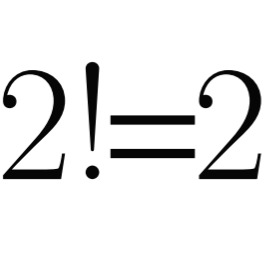논리학, 그 다섯 번째 이야기 | 이중부정 ( Double Negation )
이번 글에서는 이중부정 (Double Negation)에 대해 다룰 것이다. 이중부정은 말 그대로 하나의 wff에 부정을 두 번 적용한 것으로, 이는 원래의 wff와 논리적으로 동일하다. 즉, $\mathscr{B}$가 wff일 때 $\neg \neg \mathscr{B}$와 $\mathscr{B}$는 서로가 서로를 함의한다. 이는 타당한 추론 규칙이며, 많은 논리전개에 사용된다. 그럼 다음의 정리들을 보자.
Theorem 1. 이중부정의 제거 ( Double Negation Elimination )
| $\mathscr{B}$가 wff라면, $\vdash \neg \neg \mathscr{B} \Rightarrow \mathscr{B}$이다. |
Proof.
이 정리는 다음과 같이 증명할 수 있다.
$$ \begin{array}{rll} 1. & \left( \neg \mathscr{B} \Rightarrow \neg \neg \mathscr{B} \right) \Rightarrow \left( \left( \neg \mathscr{B} \Rightarrow \neg \mathscr{B} \right) \Rightarrow \mathscr{B} \right) & \href{https://chocobear.tistory.com/151}{\color{#006DD7}{\text{(A3)}}} \\ 2. & \neg \mathscr{B} \Rightarrow \neg \mathscr{B} & \href{https://chocobear.tistory.com/152}{\color{#006DD7}{\vdash \mathscr{B} \Rightarrow \mathscr{B}}} \\ 3. & \left( \neg \mathscr{B} \Rightarrow \neg \neg \mathscr{B} \right) \Rightarrow \mathscr{B} & \text{1, 2, }\href{https://chocobear.tistory.com/153}{\color{#006DD7}{\mathscr{B} \Rightarrow \left( \mathscr{C} \Rightarrow \mathscr{D} \right), \mathscr{C} \vdash \mathscr{B} \Rightarrow \mathscr{D}}} \\ 4. & \neg \neg \mathscr{B} \Rightarrow \left( \neg \mathscr{B} \Rightarrow \neg \neg \mathscr{B} \right) & \href{https://chocobear.tistory.com/151}{\color{#006DD7}{\text{(A1)}}} \\ \hline \therefore & \neg \neg \mathscr{B} \Rightarrow \mathscr{B} & \text{3, 4, }\href{https://chocobear.tistory.com/153}{\color{#006DD7}{\text{HS}}} \end{array} $$
따라서 $\vdash \neg \neg \mathscr{B} \Rightarrow \mathscr{B}$이다.
$\blacksquare$
앞으로 이중부정의 제거는 DNE로 줄여서 사용할 것이다.
Theorem 2. 이중부정의 도입 ( Double Negation Introduction )
| $\mathscr{B}$가 wff라면, $\vdash \mathscr{B} \Rightarrow \neg \neg \mathscr{B}$이다. |
Proof.
이 정리는 다음과 같이 증명할 수 있다.
$$ \begin{array}{rll} 1. & \left( \neg \neg \neg \mathscr{B} \Rightarrow \neg \mathscr{B} \right) \Rightarrow \left( \left( \neg \neg \neg \mathscr{B} \Rightarrow \mathscr{B} \right) \Rightarrow \neg \neg \mathscr{B} \right) & \text{(A3)} \\ 2. & \neg \neg \neg \mathscr{B} \Rightarrow \neg \mathscr{B} & \text{DNE} \\ 3. & \left( \neg \neg \neg \mathscr{B} \Rightarrow \mathscr{B} \right) \Rightarrow \neg \neg \mathscr{B} & \text{1, 2, }\href{https://chocobear.tistory.com/151}{\color{#006DD7}{\text{MP}}} \\ 4. & \mathscr{B} \Rightarrow \left( \neg \neg \neg \mathscr{B} \Rightarrow \mathscr{B} \right) & \text{(A1)} \\ \hline \therefore & \mathscr{B} \Rightarrow \neg \neg \mathscr{B} & \text{3, 4, HS} \end{array} $$
따라서 $\vdash \mathscr{B} \Rightarrow \neg \neg \mathscr{B}$이다.
$\blacksquare$
앞으로 이중부정의 도입은 DNI로 줄여서 사용할 것이다. 또한, 서술 과정에서 DNE인지 DNI인지 맥락으로부터 쉽게 유추할 수 있는 경우 간단히 DN으로 나타낼 것이다.
'수학 > 논리학 | Mathematical Logic' 카테고리의 다른 글








